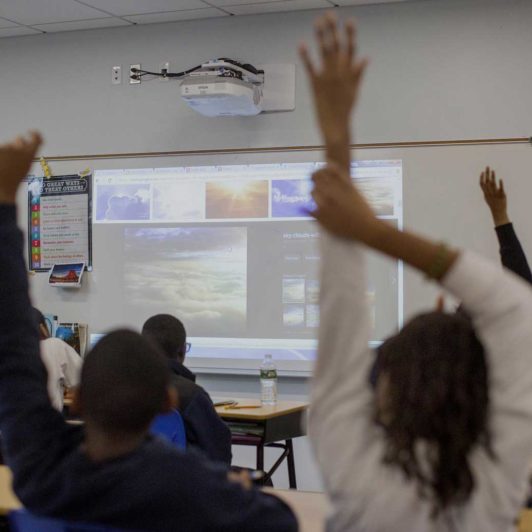This article originally appeared on Data Clinic’s blog on Medium.
Widespread and equitable access to arts and culture is an important aspect of any city’s community planning. Art programming can provide meaningful opportunities for community engagement, creativity, and togetherness — something we’ve all learned to value more than ever during the Covid-19 pandemic. Therefore, ensuring equitable access to art and culture is an important priority for many arts organizations, including the Metro Nashville Art Commission, or “Metro Arts.” Metro Arts is the office of Arts and Culture for Nashville and Davidson County in Tennessee, and it strives to create a vibrant and equitable community through arts by funding nonprofit arts and cultural organizations, public art, artists and youth programs.
Each year, Metro Arts has to decide how to allocate its limited funds among a growing number of organizations. While Metro Arts’ funding has remained relatively flat over the last decade, the number of organizations applying for support has increased. This makes the decision-making process as to how much to give each organization more challenging. Metro Arts traditionally uses a holistic, qualitative review of the various organizations to determine funding allocations. While Metro Arts collects various data about its funded organizations and their projects and participants, it has historically faced many challenges to using that data effectively in its processes. These challenges include inconsistent data collection, limited staff resources and experience with data analysis. Metro Arts’ goal is to ensure that all Nashvillians have equitable access to a creative life, with a particular emphasis on ensuring that Black, Indigenous, People of Color (BIPOC) communities and communities with higher rates of poverty have the same access as everyone else.
We had the opportunity to help the organization address some of the knowledge gaps and challenges it’s faced around data analysis. We’ve also been able to apply a quantitative lens to the work Metro Arts has been doing to allocate its resources equitably.
For each category of Metro Arts’ programming, we set out to answer two questions: (1) Can we estimate the reach of Metro Arts’ funded initiatives based on currently available data? and (2) can we provide Metro Arts with data-driven insights on funding allocations going forward? We analyzed the data provided by Metro Arts holistically and supplemented it with various publicly available data sets. We also used the FY 2019–2020 data to provide more targeted insights for Metro Art’s grant applications review this year.
Public Art
In order to evaluate the current reach of public artworks and help identify public spaces in high poverty and BIPOC communities for new public art, we analyzed the locations of public art provided by Metro Arts (1989–2019). We also examined data from the US Census Bureau to better understand the demographic makeup of the communities in the vicinity of public art and used Walk Score data to quantify potential pedestrian access to these installations.
We discovered that about 50% of council districts in Nashville (out of 34) have no public artworks, which provides an opportunity for Metro Arts to expand its reach. Some Council Districts are primarily residential, since Nashville is a city/county government which includes urban, suburban and rural areas, so one possible set of potential locations for new artworks are Nashville Metro Parks, the data for which is made available through metro park boundaries dataset on the Nashville Open Data Portal. The maps below demonstrate where public artworks are located (dots), the locations of parks from Metro Park boundaries (orange regions), and census information color-coded to reflect the percentage of BIPOC population and the percentage of population living below the poverty level in each tract. From these maps, Metro Arts can glean insights about how equitably public art is distributed across different communities, in particular those with a high proportion of BIPOC and high poverty residents (i.e., the North-West and South-East regions of the city). These communities tend to have low exposure to permanent artworks and are considered “key regions” in Metro Art’s effort to ensure equitable access to public art.
To help Metro Arts identify promising candidates for public artworks in prioritized regions of the city, we leveraged the Walk Score of each region. A Walk Score, ranging from 0 to 100, quantifies how “walkable” a neighborhood is by assessing various factors such as nearby amenities, accessibility to public transport, walking routes, and population density. It can serve as a proxy for accessibility of a location, indicating that there’s a higher likelihood that people would visit public art in an area with a higher Walk Score. The map below demonstrates the average Walk Score for each census tract in Nashville. Not surprisingly, the highest average Walk Scores are in the downtown areas of Nashville (80–100), while parts in the South-East have relatively high scores as well (above 50). Because most public art installations are in the downtown area of Nashville, they are located in regions with a high Walk Score. Since some of the factors that are considered in Walk Scores are also commonly associated with more expensive neighborhoods in cities, we assessed potential bias in the Walk Score (i.e., is a higher Walk Score correlated with higher income and/or lower BIPOC proportions in an area), but did not find significant evidence of these associations. Therefore, each region’s Walk Score can be a helpful metric for Metro Arts to consider going forward in terms of selecting easily accessible locations for public art. Metro Arts particularly appreciated this insight, as its assumption was that high Walk Score neighborhoods are limited to predominantly less diverse neighborhoods. “There are plenty of high Walk Score BIPOC neighborhoods we can consider for future public art,” said Janine Christiano, Strategic Funding and Initiatives Manager at Metro Arts.
We provided different metrics including average Walk Score, percentage of BIPOC and low-income residents, nearby public art, and nearby parks for all of the parks available in the Nashville metro park boundaries database. We then highlighted specific parks that could be of interest to Metro Arts, due to their proximity to neighborhoods with underserved populations and fewer current nearby installations (such as Ted Rhodes Park, White Creek Park, and Grassmere Park). We will also provide Metro Arts with code to generate these types of metrics for any new location going forward. These metrics, when used in conjunction with more qualitative information, can help Metro Arts to determine potential future locations for public art installations that expand access to underserved communities.
Funded Organizations
Each year, Metro Arts provides funding for an increasing number of organizations (over 60 in 2018) that organize art and culture projects in hundreds of locations including schools, parks, and museums. Data about the funded organizations and their project locations from 2015–2017 and 2019–2020 includes a self-reported number of participants and event occurrences at each location. We combined this with information from the census to help analyze these organizations’ reach to BIPOC and low-income communities and to provide insights into potential locations for increasing equitable program reach.
As discussed above in the context of public art, we identified certain “key regions,” highlighting areas that have a high number of BIPOC and people living in poverty, but that do not have a high concentration of permanent public artworks (i.e., the northwest and southeast parts of Nashville). The maps below show all project locations in red and the size of each population category for each census tract in teal circles.

We faced a number of challenges in the process of understanding an organization’s reach. First, we don’t actually have data on who is accessing these projects — so quantifying their exposure requires a number of assumptions and proxies. Since we do have data on the locations of the initiatives, we were able to use data from the census to figure out the demographic makeup in the vicinity of these locations. First we drew a circle around each project using a radius of 1 mile to represent the participating population, and from there we estimated the potential reach for different organizations based on the locations they operate in.
Of course, it can be hard to compare different types of funded projects and organizations on the same scale because their catchment areas (i.e., the geographic areas they serve) can be very different. For example, an organization like Nashville Symphony is expected to reach many people around the city outside of its immediate radius for Symphony productions, since many will travel to attend these types of events. For smaller, more local organizations like the Porch Writers’ Collective, we assumed that people within a 1 mile radius would be more likely to attend than those living further away. Therefore, when conducting the analysis on the reach of funded projects, we excluded certain project locations with a large number of participants, since estimating participation based on vicinity is likely not valid.
Reach was measured across several dimensions, including percentage of BIPOC population and people living in poverty in the vicinity of each program location, what types of locations the activities typically take place in, whether the organization’s program locations are in the key regions described above, and the number of participants and events reported by organizations.
There is a significant variance in the percentage of BIPOC and percentage of people living in poverty in the vicinity of each project location. The plot below compares the percentage of overall BIPOC population each organization could reach versus the average percentage of the BIPOC population in the vicinity. The dot size is scaled by the number of locations each organization operates in. This data can support efforts to focus funding on organizations that work in areas with a high proportion of the target demographics while simultaneously reaching a significant portion of the population, as well. The arrows show the direction in which these dots could move in the future to increase programming to more diverse locations (by targeting organizations that have a high overall reach across Nashville and also have a large BIPOC population in the vicinity) or that could widen local reach (by looking at organizations with relatively lower overall reach that typically work in high minority neighborhoods).
We also used data from the census to help identify access trends across different location types, with certain locations such as public schools, organizations receiving the Thrive grant, libraries, and arts and culture facilities reaching a larger percentage of the target communities as compared to other location types. Funding activities in these locations can potentially help Metro Arts increase arts access to underserved communities.
School Programs
In order to evaluate the reach and diversity of schools served by organizations that receive Metro Arts’ grants, data on organization-school partnerships, including the estimated number of students reached through school programming and school locations (2015–2017; 2018–2020) was supplemented with Metro Nashville Public School (MNPS) enrollment data.
On a high level, organizations working with schools typically engage with about 5 to 10 schools, and each school generally receives support from 1 or 2 organizations. The majority of the partnerships are with MNPS, which also have a higher proportion of BIPOC students than the general population in Nashville under 18. Given Metro Arts’ high engagement with MNPS, as well as a lack of data on non-public schools, we focused the analysis on public rather than private schools.
As with public artworks and funded projects, we conducted analysis across a number of different metrics to measure potential reach of each organization’s work with schools, including the number of public schools working with the organization, the overall proportion of the student population potentially reached by programming, and detailed statistics broken down by key characteristics (i.e., by race/ethnicity, students with limited English proficiency, students with disabilities, and economically disadvantaged students). In particular, we provided information about the percentage of the overall MNPS student population for each socio-demographic group that each organization can potentially reach (e.g., of all economically disadvantaged students in MNPS, how many attend schools working with a particular organization).
Metro Arts can see how its grantees are doing in terms of reaching schools with higher populations of its target demographics. The chart below demonstrates the total students per school broken down by demographic categories (in orange), compared to the students in those same categories reached by Metro Art grantees (in teal). Overall, Metro Art grantees are serving different student populations on a level that’s close to the city average. They’re serving a relatively high number of schools with greater Hispanic/LatinX student populations, and a more narrow range of schools with Black students.
We compared the percentage of low-income and BIPOC students each organization can potentially reach versus the average percentage of those demographics in schools each organization works with. This comparison helped us identify organizations that work in schools with higher populations of the target demographics while simultaneously reaching a significant proportion of the overall student population of each demographic as well. The scatter plots below demonstrate this comparison and the dots are scaled to represent the number of public schools each organization works with.
We also helped identify schools not currently reached by funded organizations that would help expand access to Metro Arts’ target demographics because they have both a large school population and a high proportion of target demographics. A deeper analysis on organizations’ reach to schools over time would be needed to prioritize these schools, since organizations have full discretion to select the schools they work with. Organizations that have expanded their reach in the past may be more receptive to expansion in the future, and additional funding may or may not have an impact on an organization’s desire to expand reach. Given its relationship with grantees, Metro Arts can supplement its understanding of these dynamics with the results from our analysis to inform longer term decisions on expanded reach in schools.
Key Takeaways
Overall, funded organizations’ focus on public schools skews toward Metro Arts’ target demographics, and grantees already have a significant reach within MNPS. To further equitable engagement to arts programming in schools, Metro Arts can work with organizations to focus on schools serving BIPOC students and those that are geographically isolated from other schools with funded programs.
In addition to the insights into how to expand equitable access to arts programming, this project helped to highlight the importance of data quality and consistency. Metro Arts indicated that an audit of their data collection methods and current data would have been very helpful from the start of the project. “We discovered during the process how much of our data needed clean-up to be usable and what we eventually needed to update,” said Christiano.
Metro Arts is excited to use the insights from this project in both the public artwork selection process and annual grants allocation process. “We now have a clear idea of what organizations have been most successful in reaching high-poverty and BIPOC communities, so we can begin to dig deeper and look at what exactly these organizations do well that contributes to this impact, and help other organizations grow in this way. We also know what locations will be most impactful and most in line with our strategic goals,” Christiano indicated.
A special thanks to Metro Arts for their collaboration and to Lilia Stantcheva for writing this blog.






